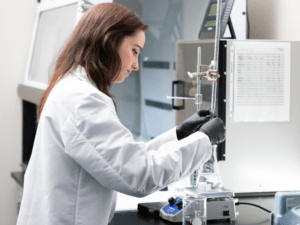The term “forever chemical” sounds dystopian, but it is a real nickname for a new contaminant in our drinking water and it’s here to stay.
A Brief History of PFAS
Polyfluoroalkyl substances (PFAS) are a group of man-made chemicals produced primarily from carbon and fluorine. Sharing an extremely strong carbon bond, they create a uniquely tough structure with the properties to resist water, grease, and heat. For nearly a century it was a revolutionary solution, sprayed on objects to keep them free of unwanted grime. If it seems too good to be true, that’s because it is.
Created by accident in a laboratory in 1936, its first application was as a covert substance utilized in the Manhattan project, where it kept Uranium radiation from escaping its containment. By the mid-20th century, PFAS had gone mainstream — clothing, cookware, carpets, automobile parts, and even vascular grafts.
However, its continual production and high solubility has spread microscopic particles into crucial water sources. This has resulted in the detection of PFAS inside people, plants, and animals. Leading to the ethics of continued PFAS production coming into question after receiving its first EPA regulatory framework, supported by research finding PFAS to cause extreme health effects.
Why PFAS in Drinking Water Is a Big Problem
PFAS has an extremely long half-life, meaning that it can take upwards of a few decades for a singular particle to break down even partially in the body. The long-term presence of PFAS inside the body can create adverse health effects.
- Cancers
- Liver issues
- Hormonal imbalances
- Cardiovascular blockages
- Immune system failures
- Birth defects
With 45% of United States water systems found to be disseminating water containing PFAS to households and businesses, the concern for exposure is tangible.
In response, the EPA has published enforcement on PFAS contamination levels for Public Water Systems (PWS). These regulations are stringent, requiring most PFAS compounds remain at 4 ng/L or less within water sources. This is a very large leap from no regulation at all, and although the substance is stubborn there are technologies available that can remove it during water treatment and meet these new limits.
Can PFAS Be Removed from Drinking Water?
Yes — but it requires advanced filtration. Here are three proven PFAS treatment technologies:
- Granular Activated Carbon (Adsorption)
Granular Activated Carbon (GAC) is highly effective at capturing PFAS through adsorption. Adsorption is a well-studied filtration process in which GAC acts as a passage for specific particles (H2O) and as a wall to others, like PFAS. The fluorine atoms in PFAS are attracted to the carbon in GAC, choosing to “stick” to the particles instead of passing them by, ultimately eliminating PFAS from source water.
- Reverse Osmosis (RO)
A popular physical filtration process containing a semi-permeable membrane. RO allows only the passage of H2O molecules to continue through the treatment process. Great for systems of all sizes, Reverse Osmosis is very reliable and practical for the removal of contaminants like PFAS.
- Anion Exchange
For water treatment systems of smaller sizes, it can be more practical to use Anion Exchange for PFAS. An important component in pH monitoring, PFAS is removed by chemically altering the pollutants and reducing their acidic quality.

Real-time monitoring and EPA-verified quality standards ensure reliability.
Why PFAS Still Get Through Public Water Systems
Despite the new EPA regulations, many public water systems aren’t equipped with the infrastructure or funding to keep up with newer hazards. Reasons PFAS continue to spread include:
-
High costs associated with testing and filtration
-
High water demand in large population areas
-
Lack of public awareness and urgency
PFAS Treatment for Remote and Mobile Work Sites
Roughly 77% of source water contains PFAS, making it essential to protect workers on job sites. WaterFleet offers mobile infrastructure that helps crews avoid exposure.
Our Water System combines:
-
Reverse Osmosis
-
Activated Carbon Filtration
-
Anion Exchange
These same technologies are used again in our Reclaimer System, ensuring clean water on both the supply and treatment side. Compact, modern, and scalable, WaterFleet’s infrastructure brings PFAS-safe drinking water wherever the job takes you.
Ready to Act?
If you’re managing a mobile workforce or remote site, WaterFleet can help you meet the latest EPA requirements and safeguard your team.
Contact us today to learn more about PFAS treatment solutions for your site.
Written by: Raegan Kripal, Sustainability Intern
